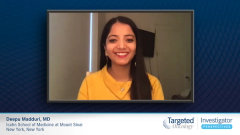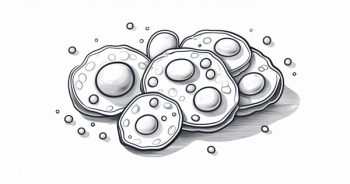
Impressive Responses from Cilta-Cel for RRMM
Deepu Madduri, MD, details the efficacy data from the phase 1b/2 CARTITUDE-1 study of ciltacabtagene autoleucel (cilta-cel) for relapsed/refractory multiple myeloma.
Deepu Madduri, MD: When it comes to response and overall response rate, one interesting thing to talk about, which we talked about in the MAMMOTH study, is that patients who are triple refractory have a median overall survival of less than 9 months. If they’re penta refractory, it’s less than 6 months. What we found on the CARTITUDE-1 study is that the overall response rate in this heavily pretreated patient population was 97%, with 67% stringent CRs [complete responses] and 93% VGPR [very good partial response] or better. This is after a 1-time infusion. What’s even more impressive is that these responses are ongoing in 72% of patients at the time of the data cutoff—12.4 months.
We talked about how the overall survival in this heavily relapsed patient population should be less than 6 months. What we saw on this study is that we have not reached a median PFS [progression-free survival]. At a data cutoff of 12.4 months, the PFS rate was 77%, with no median PFS reached. We also tried to see what the median PFS would be if we split it by dose responses. In regard to patients’ 12-month PFS, if you’re in stringent CR, the PFS was 85%. If you’re in VGPR, it was 68%. Again, the median PFS was not reached in either group. We also saw that the 12-month overall survival rate was 89%.
What’s interesting is that we see, in conclusion, that cilta-cel [ciltacabtagene autoleucel] has a very manageable safety profile at the recommended phase 2 dose. Most of the CRS [cytokine release syndrome] was grade 1 or 2. The median time of onset of CRS was 7 days, opening up the opportunity for outpatient administration. We saw CAR [chimeric antigen receptor] T-cell–related neurotoxicities in about 21% of these patients, with grade 3 or higher being about 10%. Low doses of ciltacabtagene autoleucel yielded early, deep, and durable responses in this heavily pretreated patient population, with a 97% overall response rate and stringent CR rate of 67%. Seventy-two percent of these patients still maintained their response at the time of data cutoff. We didn’t reach a median PFS, and the 12-month PFS rate was 76%. In addition, ciltacabtagene autoleucel is being investigated in other populations, particularly in earlier-line settings in multiple myeloma, in our CARTITUDE-2 and 4 programs.
Transcript edited for clarity.










































